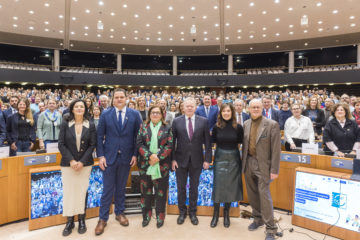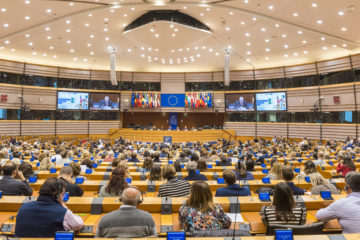The European Commission reaffirms the importance and effectiveness of LEADER for European rural areas
The European Commission’s Directorate-General for Agriculture and Rural Development has published a special report on the European Rural Development LEADER Program, entitled “Evaluation support study of the costs and benefits of the implementation of LEADER”, which stresses the importance and effectiveness of the implementation of this program in Europe.
The European Commission’s Directorate-General for Agriculture and Rural Development has published a 198-page in-depth analysis to determine whether the LEADER approach generates benefits that justify the additional costs and risks it entails, in relation to the general (top-down) EU funding programs. This report, published a year after the one of the European Court of Auditors which questioned the implementation of this program, uses a mixed evaluation approach that integrates both qualitative quantitative and technical measures together with analyses conducted at three territorial levels, allowing it to highlight the added value of this program.
A report that assesses the impact of LEADER beyond a strictly budgetary approach
Launched in 1991, the LEADER program – the European Union’s bottom-up participatory rural development policy – is the only European program dedicated to supporting rural development projects. The LEADER approach is based on local development led by local actors, and relies on experimentation, cooperation, capitalization, dissemination of good practices and pooling of resources and networks.
This evaluation support study uses a mixed evaluation approach that integrates both qualitative and quantitative and technical measures together with analyses conducted at three territorial levels: on the whole of National and Regional Rural Development Programs (RPDs), a focus on a smaller number of RDPs and on Local Action Groups case studies identified from selected RDPs.
« Our European federation has contributed to this assessment, and we welcome this new report from DG AGRI, following the one from last year by the Court of Auditors. The latest report of the Court of Auditors pointed out that, because of its participatory approach, LEADER has high administrative and operational costs compared to other programs. We regretted at the time the choice to assimilate this participatory program, which is developed in more than 2800 territories in Europe, to a «risk-benefit» approach. The choice of evaluators to assess at three territorial levels based on quantitative and qualitative data is a positive signal sent to rural territories on the understanding of the program » says Thibaut Guignard, president of ELARD.
The report stresses that LEADER is not the most expensive measure of the EAFRD. The average administrative cost of the LEADER measure is estimated at 5.5 cents per € 1 committed, which is well below the same cost of measure 6, aiming at supporting economic development and promoting job creation in rural areas (12 cents), or that of measure 16, which aims at different forms of cooperation, involving at least two entities among actors in rural areas (13.4 cents), but being only slightly higher than that of measure 7 which aims at supporting the development of the rural economy, local infrastructure and low-cost services (4.9 cents).
« The funding allocated to the operation of Local Action Groups is well beyond “administrative costs”, as it allows for an invaluable investment in human resources, animation and valuable networking work. It is one of the success factors that LEADER offers a regional management that supports the commitment and creativity of local actors in implementing their ideas for the benefit of their region. At ELARD, we believe that LEADER is way more than just a financing tool, but a true rural development program. For territories, the importance of this program is well beyond its direct financial impact » adds Thibaut Guignard.
LEADER: More than just a financing tool, a European rural development program to be promoted.
In this report, the evaluators acknowledge that the implementation of LEADER has led to the establishment of an effective multi-level governance system, enabling both a reduction in the time beneficiaries spend on administrative tasks, thanks to the support provided by the LAGs, and an increase in the participation of potential beneficiaries who would otherwise not apply for LEADER funding.
« The LEADER programs have helped to develop rural areas in Europe and stimulate territorial dynamics. These programs are perfectly adapted to support the new local initiatives in our territories, as it is necessary to innovate, to experiment, and to build partnerships between the public sector and private actors. More than a financing tool, LEADER is a rural development program with its own fundamentals: networking of local actors, bottom-up approach, capitalization and dissemination of good practices, cooperation. Compared to traditional funding, the territorial effects of LEADER-funded projects are enhanced, mainly because LAGs are effective in promoting networking of local actors and creating synergy around a territorial strategy » highlights Thibaut Guignard.
ELARD agrees with DG AGRI’s recommendations, namely: to further reduce the administrative burden on LAGs and LEADER project leaders, to define new indicators and « factual data » to assess the added value of the LEADER program in a relevant and concrete way, and to recognize Local Action Groups. With this in mind, LEADER France and the European LEADER networks are calling on the European Commission, as well as the managing authorities of each Member State, to clearly initiate joint work in response to the report’s recommendations.
« LEADER, and more generally, local development led by local actors end up to more than ever as one of the answers for a Europe closer to its citizens, but also for facing the pressure on democracy by enabling a greater appropriation of European policies. This report is a good response to the European Court of Auditors. It is necessary for the European Commission and Member States to act in order to give more visibility to the LEADER program for the 2023-2027 programming period », concludes Thibaut Guignard.

